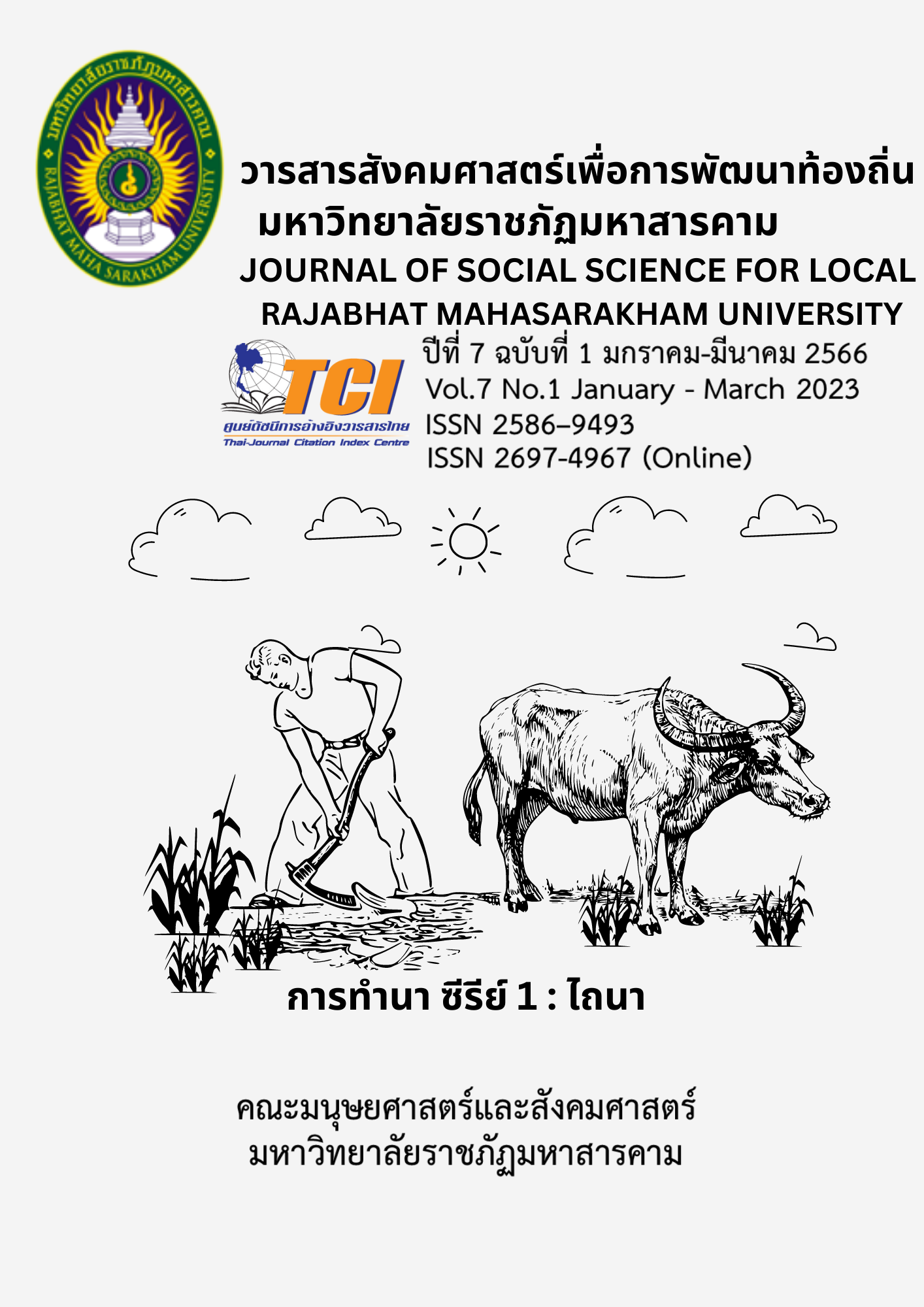นิเวศวัฒนธรรมลุ่มน้ำลำปาวสู่การพัฒนายั่งยืน
คำสำคัญ:
นิเวศวัฒนธรรม, การพัฒนา, ความยั่งยืนบทคัดย่อ
งานวิจัยนี้ มีวัตถุประสงค์ 1. เพื่อศึกษานิเวศวัฒนธรรมของผู้คนและชุมชนในลุ่มน้ำลำปาว ทั้ง 3 อำเภอ ได้แก่ อำเภอเมืองกาฬสินธุ์ อำเภอยางตลาด และอำเภอร่องคำ จังหวัดกาฬสินธุ์ 2. เพื่อศึกษาทุนทางวัฒนธรรมของผู้คนและชุมชนในลุ่มน้ำลำปาว ทั้ง 3 อำเภอ ได้แก่ อำเภอเมืองกาฬสินธุ์ อำเภอยางตลาด และอำเภอร่องคำ จังหวัดกาฬสินธุ์ และ 3. เพื่อบูรณาการนิเวศวัฒนธรรมนำไปสู่แผนพัฒนาอย่างยั่งยืนของผู้คนและชุมชนในลุ่มน้ำลำปาว ทั้ง 3 อำเภอ ได้แก่ อำเภอเมืองกาฬสินธุ์ อำเภอยางตลาด และอำเภอร่องคำ จังหวัดกาฬสินธุ์ เป็นการวิจัยแบบเชิงคุณภาพ มีเครื่องมือการวิจัย คือ แบบสัมภาษณ์ โดยมีกลุ่มเป้าหมาย จำนวน 15 คน ที่มาจากการเลือกแบบเจาะจง ประกอบด้วย กำนัน หรือ ผู้ใหญ่บ้าน ผู้สูงอายุในชุมชน ปราชญ์ท้องถิ่น และประชาชนทั่วไป แล้วนำข้อมูลที่รวบรวมได้จากเอกสารต่าง ๆ ที่เกี่ยวข้อง และแบบสัมภาษณ์มาวิเคราะห์แบบเชิงเนื้อหา ผลการวิจัยพบว่า 1) นิเวศวัฒนธรรมของผู้คนในชุดชน ประกอบด้วย (1) ด้านสังคม (2) ด้านเศรษฐกิจ (3) ด้านสิ่งแวดล้อม 2) ทุนทางวัฒนธรรมในอดีตมีความเจริญและมีผู้คนเข้ารวมประเพณีประจำเดือนมากหมาย มีความเชื่อในเรื่องของตำนานและยึดถือความเชื่อเป็นอย่างมาก แต่ในปัจจุบันนี้ ทุกอย่างมีการเปลี่ยนไป เนื่องจากเกิดจากการเปลี่ยนแปลง การปรับตัว ของสังคม เศรษฐกิจ และสิ่งแวดล้อมที่เปลี่ยนไป และ 3) การบูรณาการนิเวศวัฒนธรรมนำไปสู่แผนพัฒนาอย่างยั่งยืนได้ นั้นมีข้อจำกัดในเรื่องของงบประมาณ ความรู้ที่ส่งเสริมแปรรูปจากวัตถุดิบที่มี และการส่งเสริมการตลาดในการจำหน่าย ซึ่งหน่วยงานของรัฐเข้าถึงในส่วนขององค์การบริหารงานส่วนตำบลในแต่ละแห่งเท่านั้น ขาดงบประมาณในการส่งเสริมอาชีพของขาวบ้านไม่ต่อเนื่อง ดังนั้นเพื่อให้แผนพัฒนาของประชาชนทั้ง 3 แห่ง มีความยังยืน ควรมีการจัดทำแผนพัฒนาและลงมือปฏิบัติอย่างต่อเนื่องไม่น้อยกว่า 3 ปี ถึงจะเกิดการบูรณาการนิเวศวัฒนธรรมในทุกด้านได้อย่างยั่งยืนต่อไป



